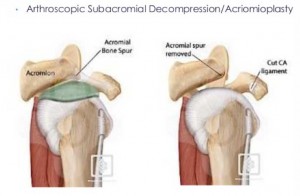Subacromial Decompression–Arthroscopic
 Subacromial Decompression is an arthroscopic procedure designed to release the tight ligament of the coracoacromial arch and to shave away some of the under surface of the acromion. This raises the roof of the shoulder, allowing more room for the rotator cuff tendons to move underneath. The tendon is then able to move more freely, breaking the cycle of rubbing and swelling of the tendon.
Subacromial Decompression is an arthroscopic procedure designed to release the tight ligament of the coracoacromial arch and to shave away some of the under surface of the acromion. This raises the roof of the shoulder, allowing more room for the rotator cuff tendons to move underneath. The tendon is then able to move more freely, breaking the cycle of rubbing and swelling of the tendon.
Subacromial Decompression (Arthroscopic) surgery is a keyhole surgery; it is commonly performed for impingement syndrome which has failed to respond to conservative measures such as steroid injection and physiotherapy. The surgery is usually carried out as same day procedure. The success rate for this procedure is around 80% but it may take a number of months, even up to a year, to see the full benefit
Preparation for Subacromial Decompression (Arthroscopic)
The Subaacromial Decompression procedure will be carried out by an orthopedic surgeon. He or she will explain how to prepare for your procedure. For example:
- Your surgeon will discuss with you what will happen before, during and after your procedure.
- Complete any pre-operative tests or lab work prescribed by your doctor.
- Arrange to have someone drive you home from the hospital.
- Refrain from taking aspirin and non-steroidal anti-inflammatory medications one week prior to surgery.
- Refrain from eating or drinking anything after midnight the night before surgery.
Subacromial Decompression (Arthroscopic) Surgery
Subacromial Decompression Arthroscopic Surgery is performed using instruments inserted through small incisions. Depending on the location of the inflammation and the extent of work that needs to be done, usually two to four small (1 centimeter) incisions are made. A small tube called a cannula is inserted into each incision to allow easy passage of instruments in and out of the shoulder without damaging the surrounding tissues. One of the instruments inserted into the shoulder is a video camera about the size of a pencil. Another instrument called a shaver is inserted through another cannula. The shaver is used to remove the inflamed bursa. Once the bursa is removed, the rotator cuff is inspected to look for any signs of a tear. The bone above the rotator cuff (the point of the shoulder) is called the acromion. Many people with bursitis of the shoulder have a bone spur that forms on the undersurface of the acromion.
Subacromial Decompression Surgery Recovery
Patients are placed in a shoulder sling following Subacromial Decompression Arthroscopic surgery, but they can begin shoulder motion quickly. There is no need for a period of restricted motion to allow for tendon healing. In cases of an isolated Subacromial Decompression, patients can begin gentle motion immediately after surgery. Strengthening can begin within a few weeks, and sports can resume after the swelling has subsided.
Recovering from Subacromial Decompression Surgery
After Subacromial Decompression (Arthroscopic) surgery you will need some shoulder rehabilitation to regain your range of motion and strength. You may be given a sling to wear for comfort, or you may just be instructed to rest your shoulder. As with any surgery, make sure you follow your surgeon’s instructions for your rehabilitation.
Recovering your range of motion and strength are the number one goals after this surgery. A full recovery usually takes 4-6 weeks, but varies for everyone. Sports activities like throwing may take 2-3 months to get back to normal. You will receive prescriptions for appropriate pain killers to use at home. Your arm may be placed in a sling or splint.
Your surgeon will instruct you and your family on the appropriate rest and/or therapy and exercises for the treatment of your shoulder instability. You will be informed of the findings at surgery.
Subacromial Decompression (Arthroscopic Risks)
There are risks and complications with the Subacromial Decompression (Arthroscopic) procedure and although they do not occur frequently, it is important to know what they are:
- There are very small risks with anaesthesia and the anaesthetist will discuss these with you on the day.
- There is a small risk of infection, probably less than 1%.
- There is a small risk of worse pain and stiffness around the shoulder in the form of a frozen shoulder, which can occasionally occur after shoulder surgery in about 1% of cases.
- There are very small risks of damage to the nerves and blood vessels around the shoulder, less than 1%. There is the occasional need to re-do the surgery, but this is rare, less than 5%.
